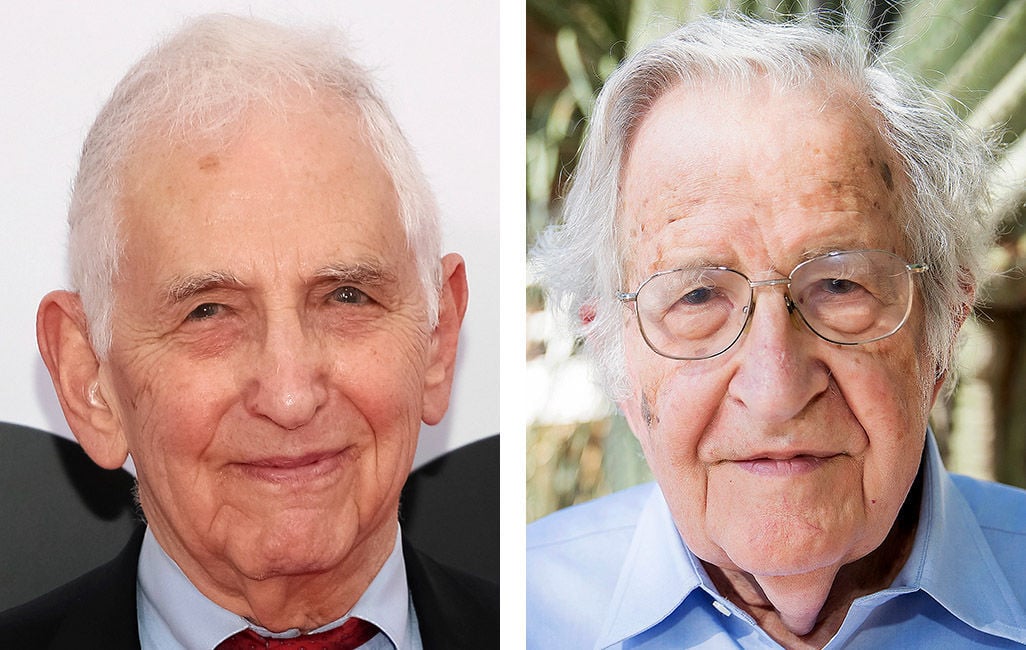The man behind the Pentagon Papers and the father of modern linguistics shared a stage at the University of Arizona on Tuesday evening, offering their assessment about the possibility of nuclear war.
Daniel Ellsberg and Noam Chomsky, who is a professor at the University of Arizona, spent roughly 90 minutes outlining why the Doomsday Clock has been set for two minutes from midnight. The point on the clock represents a threat of global nuclear war and it is set the closest to midnight since 1953, following the Soviet Union’s test of its first hydrogen bomb, ending the United States’ monopoly on nuclear weapons.
“It has never gotten that close again until last January when President Trump was inaugurated,” Chomsky told the audience.
However, he said, if scientists responsible for setting the Doomsday Clock would have read Ellsberg’s newest book, “The Doomsday Machine: Confessions of a Nuclear War Planner,” they’d have reason to inch their watches even closer to midnight.
“Page after page of the book contains graphic examples of this kind of, you can only call it ‘insanity,’” Chomsky said. “At one point you call it a chronicle of human madness.”
Chomsky offered high praise of Ellsberg’s book on Tuesday night. He called the book published last year more politically significant than the release of the Pentagon Papers.
Ellsberg, a former military analyst, is best known for leaking secret reports documenting the United States’ involvement in the Vietnam War from 1945-1967 first to The New York Times and later to the Washington Post and other newspapers.
The discussion on Tuesday night at the University of Arizona was equal parts history lesson and political criticism of current American politics. It was moderated by Betsy Reed, the editor-in-chief of The Intercept.
Chomsky offered his concerns over the number of people with their hands on America’s nuclear arsenal, saying that Ellsberg revealed it isn’t just the president.
“It is not a finger on the button, turns out it is a lot of fingers on the button,” he said.
In the book, Ellsberg explained President Eisenhower delegated the authority to admirals and generals out of concern that if Washington was suddenly destroyed in a nuclear attack, there needed to be someone to carry out a counterattack.
The logic continued down the chain of command, Chomsky warned, saying individual bomber pilots had the ability to launch a nuclear strike.
However, Chomsky said he still worried most about the biggest finger on the nuclear button, President Trump’s.
In a rare moment of levity, Ellsberg suggested that those fingers are rumored to be fairly small .
The secrets reconstructed by Ellsberg in part from memory, and from recently-declassified documents, have weighed heavily on his mind for years. Ellsberg explained that plans he helped to shape could have killed a billion people, according to one estimate.
Ellsberg said over the course of decades he slowly learned that those planners likely underestimated the lethal potential of a first strike by the United States. He said they didn’t account for the fires caused by the massive global attack and how those fires would blot out sunlight for the better part of a decade. That’s long enough, he said, for most of the world to starve to death as crops die in the first year after the nuclear strike.
One part of the plan, he explained, would have bombed every city in China in a potential war between the United States and the Soviet Union over control of the once-divided city of Berlin.
Offering anecdotes from his time in the Kennedy White House and working for the Rand Corp., Ellsberg told the audience that while he copied the Pentagon Papers he was doing the same thing to documents related to the country’s plans in case of nuclear war. He kept that a secret from his wife and his lawyers, he told the Tucson crowd.
Hidden inside a safe, those documents would be the basis of his new book decades later. He had planned on publishing them years ago, he said. But those plans were derailed when the documents — buried to keep them safe — could not be found.
Knowing he would go to jail for his role in releasing the Pentagon Papers, Ellsberg explained that he asked his brother to hide the documents. His brother buried them in a landfill but the two brothers were unable to locate the classified documents after he got out of prison.
Buried along a ridge with a stove marking its location, he explained the documents exact location were lost when a heavy tropical storm flooded the dump and moved the old iron stove.
Ellsberg attempted to get the book published without the documents but publishers balked at the premise. Ellsberg was only able to publish his confessions to the American public after the documents were declassified, he said.
Ellsberg is a senior fellow of the Nuclear Age Peace Foundation, a nonprofit dedicated to the abolition of nuclear weapons.
Sensing a dark tone for most of the 90-minute discussion, Reed asked the two academics to close the evening with a sliver of hope for the audience.
Chomsky was quick to oblige. He noted it has been more than 70 years since the last time nuclear weapons were used in war, and there is a reason to hope that they won’t be used again in the next 70 years.
“If people understand these things, and also understand something that we really haven’t gotten to, that in every single one of these crisis situations there are feasible peaceful solutions,” Chomsky said.
“They do exist in every case,” Chomsky said directly referencing North Korea and Iran. “And with enough citizen dedication and activism and pressure, I think governments can be compelled to pursue those options.”





